
Robert Natkin discovered his calling at age 17, in Chicago, when he opened a book and stumbled on the intense abstract art of Paul 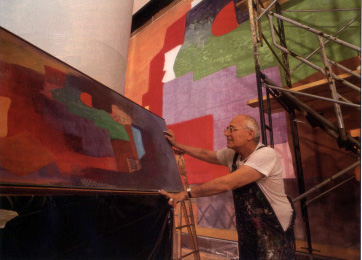 Klee. He was stunned by the beauty, the color harmonies, and the "music" in Klee’s work. So much visual activity boiled in Klee’s paintings that Natkin, seeing them in reproduction, assumed they were huge. When he finally stood before one in a museum, he was shocked to find it less than a foot square. Explaining this story now, he scrunches thumb and forefinger together and says, "I had to turn myself into a very small creature like Alice in Wonderland, and then I could enter Klee’s paintings and watch them open up and grow big."
Klee. He was stunned by the beauty, the color harmonies, and the "music" in Klee’s work. So much visual activity boiled in Klee’s paintings that Natkin, seeing them in reproduction, assumed they were huge. When he finally stood before one in a museum, he was shocked to find it less than a foot square. Explaining this story now, he scrunches thumb and forefinger together and says, "I had to turn myself into a very small creature like Alice in Wonderland, and then I could enter Klee’s paintings and watch them open up and grow big."
Given the commission to paint a 20-by-42-foot mural in the newly renovated lobby of 1211 Avenue of the Americas, Natkin, age 60, is taking a drink out of Alice’s other potion. Not entirely trusting Alice’s methods, he has made more than four dozen studies to ensure that the enlargement from his easel-size works will lose none of the emotion that he craves in his painting. He has ordered a special canvas to fit. Over the summer he has moved from his home in Connecticut in order to paint on site, from scaffolding that begins seven feet off the floor.
The wall - and its mural - is visible to traffic both in daytime and nighttime, when it glows
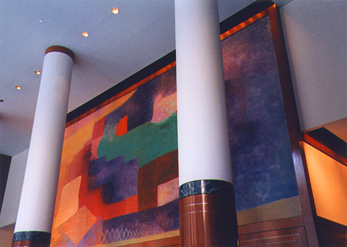 from the light of the lobby. The renovation, by architects Fellows/Martinez Associates. New York, for the building’s owner, JMB Realty, included replacement of the glazed red mosaic tiles that covered much of the walls. Most of the lobby is now pannelled in handsome, deep-toned mahagony. The remainder is a lofty glowing white. Portions of a 31-foot-tall span of white Vermont marble were left in place along the perimeter walls. Natkin’s bright color scheme - burgundies, peaches, blues - draws together the natural tones of this serene, warmly lit space, a focal point for both inside and outside.
from the light of the lobby. The renovation, by architects Fellows/Martinez Associates. New York, for the building’s owner, JMB Realty, included replacement of the glazed red mosaic tiles that covered much of the walls. Most of the lobby is now pannelled in handsome, deep-toned mahagony. The remainder is a lofty glowing white. Portions of a 31-foot-tall span of white Vermont marble were left in place along the perimeter walls. Natkin’s bright color scheme - burgundies, peaches, blues - draws together the natural tones of this serene, warmly lit space, a focal point for both inside and outside.
Natkin says, "If you do a mural, you’re a handmaiden to the architecture." But subtly so. To capitalize on the special quality of the local light, and to project beyond the glass curtain walls, Natkin began his mural by laying down a special metallic (acrylic) paint. This shiny pigment skin is covered over by ordinary matte pigments as he continues working. It will remain only as a delicate light-reflecting layer to "project" colors back to the viewer.
Natkin is a colorist by instinct and inclination, though he didn’t know it until he encoutered Klee. Born in Chicago to dysfunctional parents, he struggled against their resistance in order to become a painter. His father,
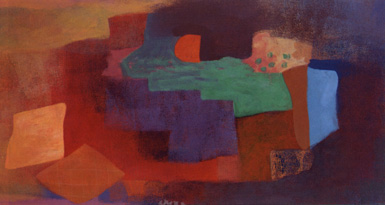 a failed tap dancer, regularly took his son to the theatre. Like many artists, Natkin has strong visual memories left from childhood. He still recalls the brilliant - even magical - colors of the stage curtain, which transported him to a new dimension as it lifted. When he came across Klee, and later Bonnard and Matisse - three of modernism’s greatest colorists - he was instantly charmed. They taught him that color carries psychological heat. The viewer, drawn in by patterns and textures, celebrated a kind of intimicy with the artist and the work.
a failed tap dancer, regularly took his son to the theatre. Like many artists, Natkin has strong visual memories left from childhood. He still recalls the brilliant - even magical - colors of the stage curtain, which transported him to a new dimension as it lifted. When he came across Klee, and later Bonnard and Matisse - three of modernism’s greatest colorists - he was instantly charmed. They taught him that color carries psychological heat. The viewer, drawn in by patterns and textures, celebrated a kind of intimicy with the artist and the work.
For Natkin, such intimacy is vitally important. It presents the possibility of escape from the daily pain of existence, and in a larger sense, from the worldly cycles of creation and destruction. Natkin believes that decorative art, which is concerned foremost with pleasure, embodies the human desire for compassion toward other beings and release from dark and destructive realities.
Pulled toward New York in the 1950s by the growing force of Abstract Expressionism. Natkin looked up fellow Chicago expatriate Robert Indiana, who took him to the local artists’ bars (including the famous Cedar Tavern). Surrounded by such powerful painters a Willem de Kooning and Mark Rothko, Natkin adopted many of their intuitive working methods. A ferocious fan of jazz, he paints with the same mix of conscious planning and improvisation. "I feel like I’m a scat artist - like a jazz singer," he says.
All these influences come to bear when he paints a mural on site. "Any work on art," he emphasizes,"has to have a hidden narrative that has to do with the material you work with and the ways it’s put down. In a sense, there’s is always a plot." In this case, the "plot" is made more complicated by a set of three columns - one squarely in the 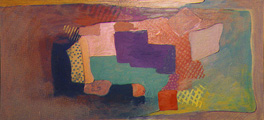 middle of the space - which interfere with a full view of the wall. The columns are structural and cannot be removed. The new design cleverly rounds them off to reduce their impact. But they have forced Natkin to think twice about his plans.
middle of the space - which interfere with a full view of the wall. The columns are structural and cannot be removed. The new design cleverly rounds them off to reduce their impact. But they have forced Natkin to think twice about his plans.
At first, his compositions were weighted more heavily on the edges and left, the center nearly empty. Eventually, he realized that the wall would primarily be seen by passerby in motion. In the final version, Natkin has rearranged the dramatic elements of the composition so that the center bears the greatest intensity. The viewer will be forced to play a form of hide-and-seek that should add some suspense to the walk-through experience.
As Natkin adds color, stippling it on with sponges and specially textural cloths, he must step back (and get off the scaffold) to judge its effects - not just within the work itself, but in a moving
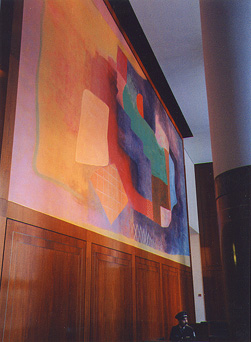 picture that includes the entire environment of the lobby. He is not bothered by these adjustments. "Aesthetics is like manure," he says, with characteristic pungency. "You use it to get the vegatables you eat."
picture that includes the entire environment of the lobby. He is not bothered by these adjustments. "Aesthetics is like manure," he says, with characteristic pungency. "You use it to get the vegatables you eat."
In Natkin’s buoyant and energetic manner is something of the eternally awestruck child. His art, in parallel with his personality, uses formal devices of shape and color - the "plot" - to chart the open canvas of primal feeling. Despite his preference for gorgeous colors, he believes there are passages of intense pathos and even fear embedded in the atmoshere of his paintings. The dark moods are redeemed by the eye’s journey back into beauty.
If this description sounds cinematic, Natkin would not disagree. He has a long-standing infatuation with Alfred Hitchcock, whose stagecraft, as the director once wrote, "dealt with life’s inescapable and frightening contradictions." He also likes to draw many of his moral examples from The Wizard of Oz - a parable, after all, about the transformative power of belief, even if it’s only belief in sham. He feels that the wizard, like the artist, creates a grand, life-sustaining myth from behind a rather flimsy curtain. If you insist on lifting the curtain, the nuts and bolts of stagecraft become obvious. But what are you left with, in that case? Better to acknowledge that life without the hope of transformation would be grim indeed.
- Kay Larson, Art Critic for New York Magazine